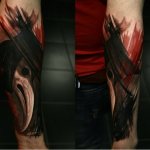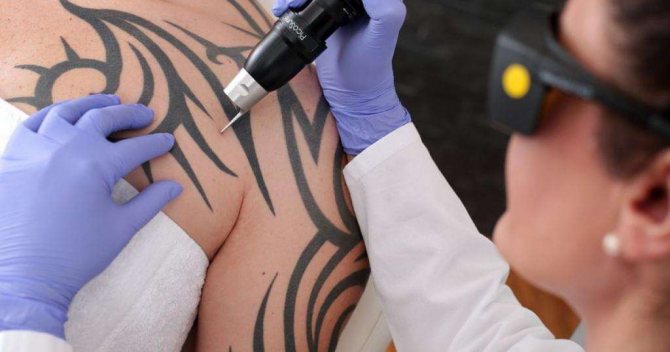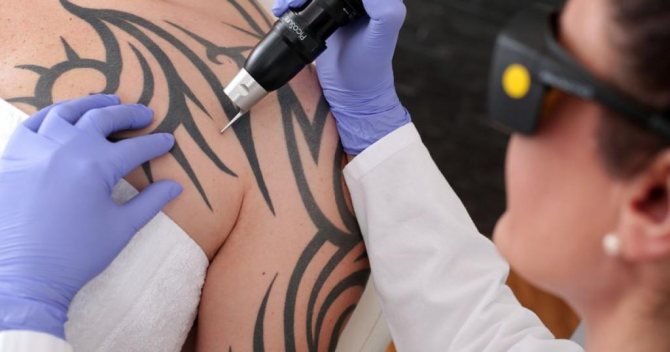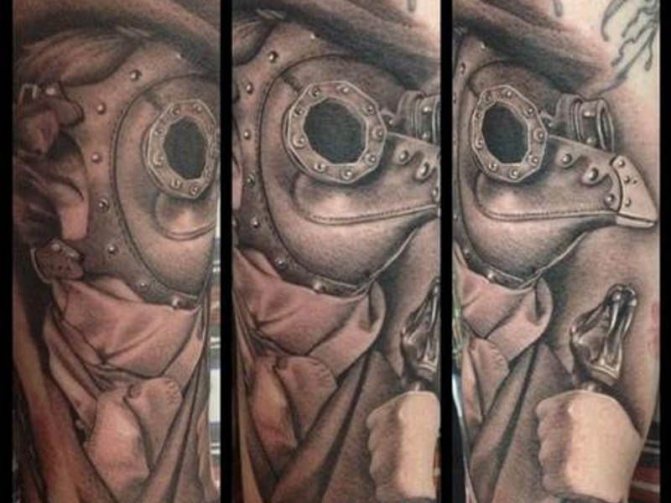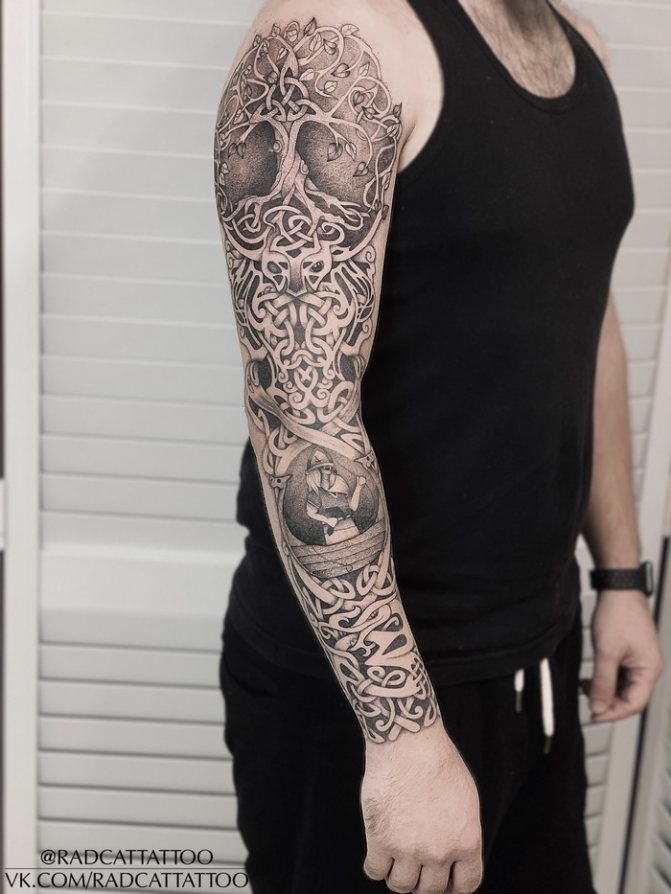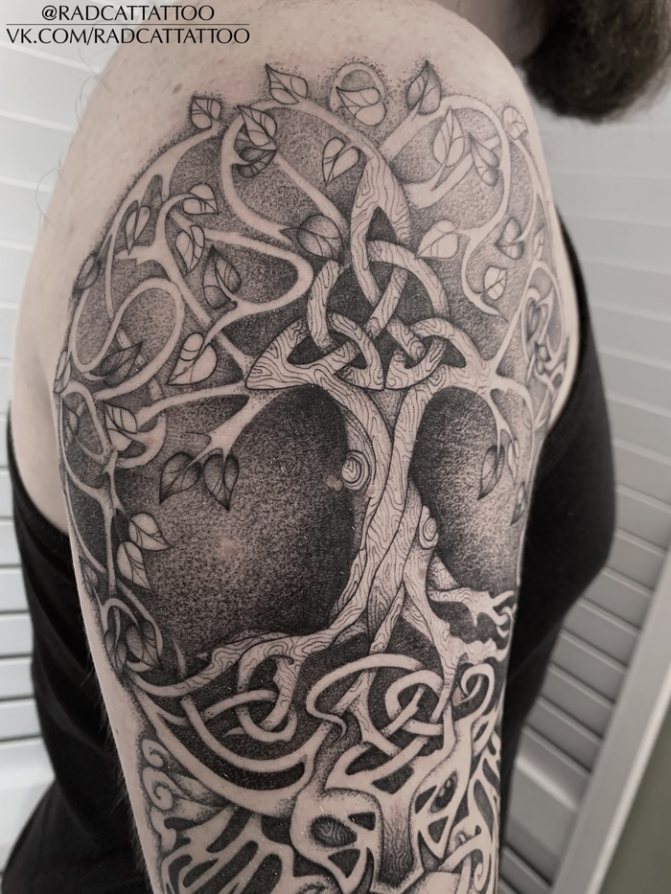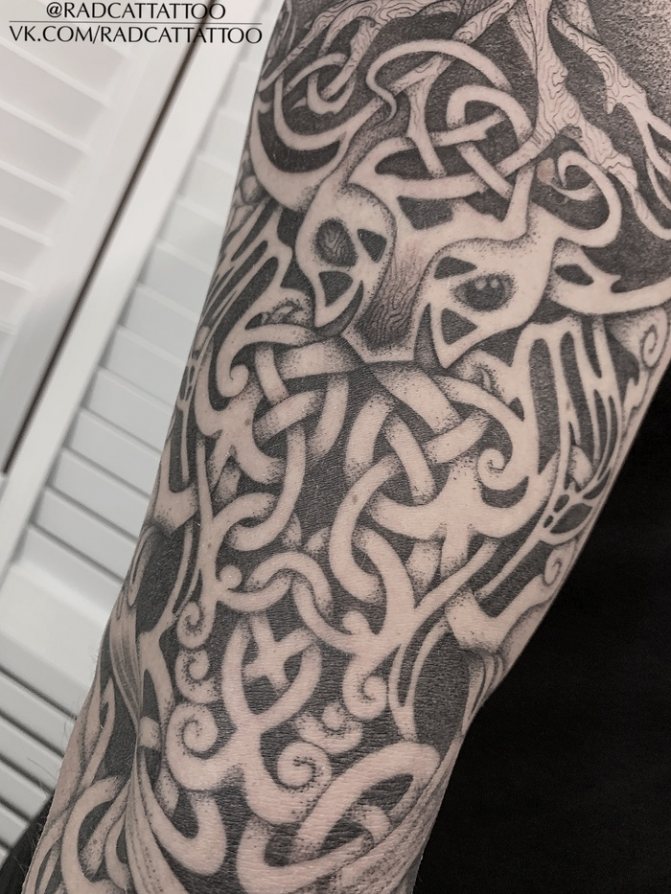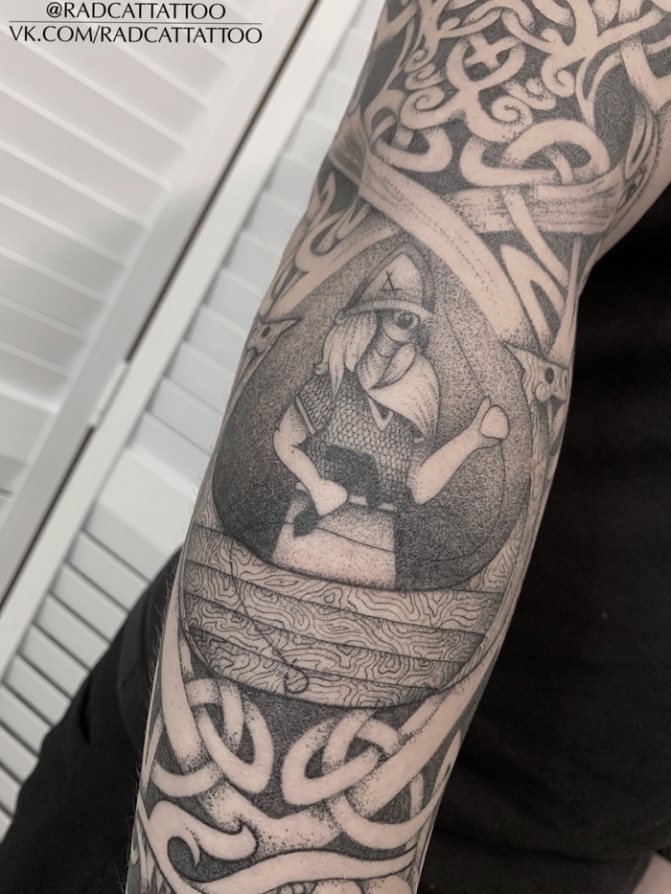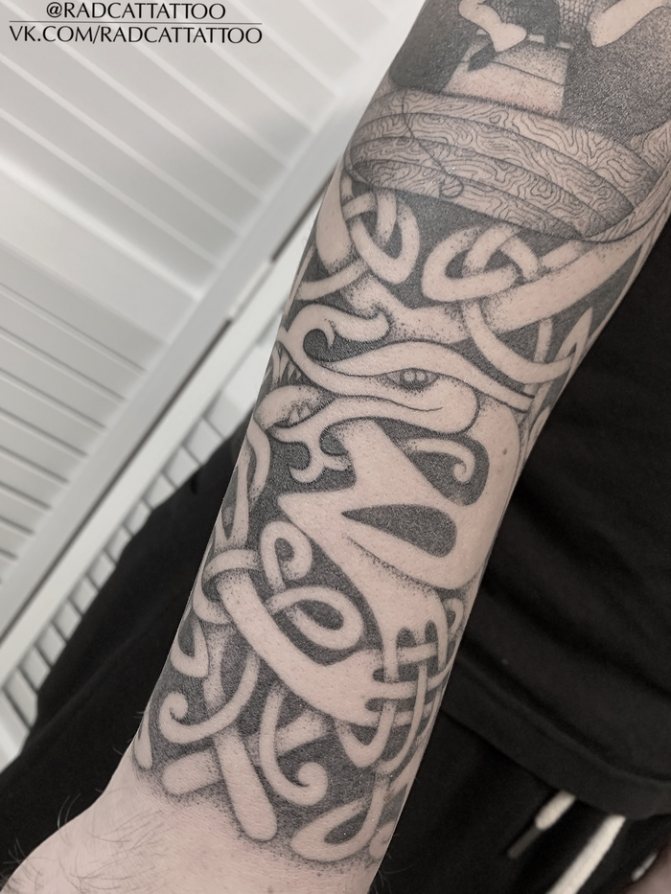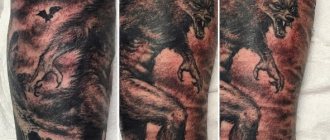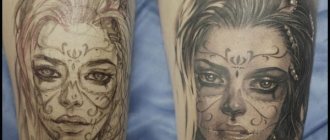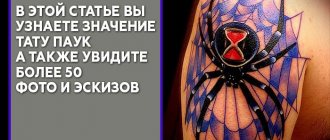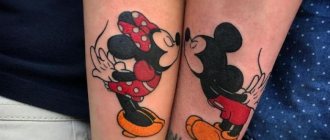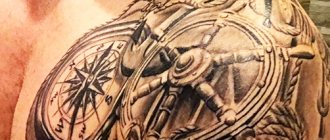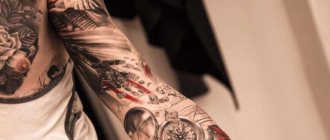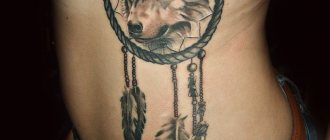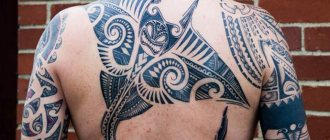Let's talk about the possible meaning of the plague doctor tattoo. This image in current European culture is surrounded by a halo of mystery and mysticism. It became popular due to the traditional costume worn by real plague doctors, and, of course, the sense of doom they evoked by their mere appearance. Not surprisingly, such a strong and unambiguous symbol has become one of the popular themes for tattoos.
In reality, however, there was nothing mythical about the actual profession. Danger, fear, stench and death were what really surrounded the plague doctor.
A brief historical excursus
The image of the plague doctor and all the symbolism associated with him belong exclusively to European culture.
In the overcrowded European cities, where total unsanitary conditions prevailed, the plague grew into a pandemic of truly horrific proportions. The medicine of that time can hardly be called medicine as we understand it now. It was more a mixture of certain theological ideas and outright quackery. Even minor illnesses were occasionally fatal, to say nothing of such a dangerous disease as the plague. Ordinary physicians could in no way prevent the spread of the disease and cure the sick. The activities of plague doctors were not very successful either, but they still managed to achieve some positive results. Their work was mainly limited to cutting and cauterization of buboes and bloodletting. Because of the danger to which they were constantly exposed, plague healers could not be full-fledged members of society and have contact with the general masses, they were often placed under quarantine.
Such a recognizable costume appeared only at the beginning of the XV century, although the profession itself existed since the middle of the XIII century. The final form of the costume was designed by the French physician Charles de Lorme. The main purpose of this garment was to protect the doctor from infection. Until then, medics wore different protective garments, and it wasn't until 1619 that the standard costume was developed.
The mask with a bird's beak gave the doctor a certain resemblance to the Egyptian god Thoth and was designed to ward off the plague. However, it did not only act as a talisman. In the beak was placed a mixture of medicinal herbs with a strong odor, which saved the doctor from the plague stench. The mask also had special glass inserts to protect the eyes. The red glass was believed to make the doctor invulnerable to disease. In addition to the mask, the costume consisted of a long cloak covering the doctor from neck to ankles, narrow pants, gloves, boots, and a hat. All these elements were sewn from waxed leather.
By the way, the famous Nostradamus was also at one time a plague doctor.
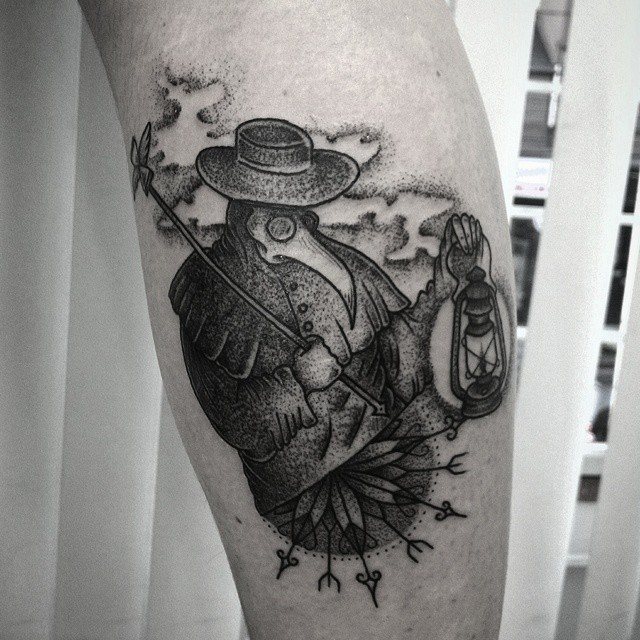
History of origin
Due to certain historical obligations, the plague doctor tattoo is quite common only in Europe. For the rest of the world it does not carry any meaningful load. The fact is that the Middle Ages for large European cities were marked by a monstrous epidemic of bubonic plague, from which a huge number of people died every day. The level of development of medicine at that time was so low that people could die of a common cold, let alone more serious illnesses.
It was under these conditions that the plague doctors appeared. Their main duties included cauterizing buboes and drawing blood from infected people. Because of their constant close contact with lepers, plague doctors were not allowed to come into contact with large numbers of people, forcing them to live in isolation.
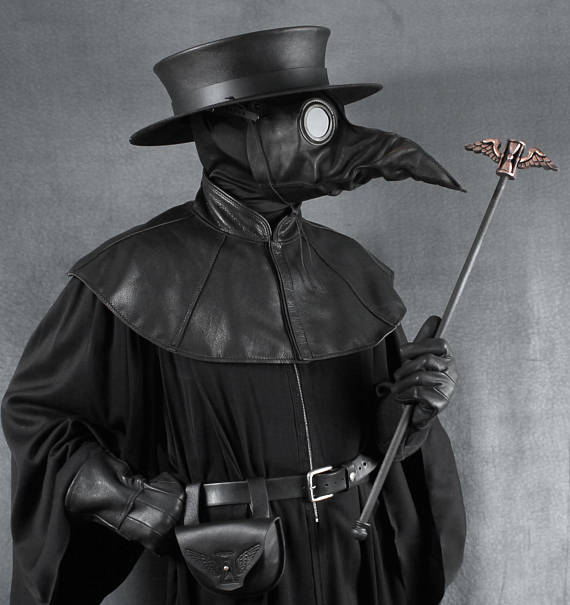

Understandably, such dangerous work had to be accompanied by special clothing. Although there were many variations of such attire, the only widely recognizable costume today is a long black cloak, a wide-brimmed hat, pants, gloves, boots and a special mask of a plague doctor. The most distinctive feature of the latter was the presence of a bird's beak, which was supposed to scare the disease away from the doctors.
The plague doctor in tattoo culture
The plague doctor tattoo is the choice of brave people who are not afraid of appearing too gloomy or of being misunderstood. This image knows no gender differences, the plague doctor is depicted on his body, both men and women, because it indicates the character traits or worldview inherent in both sexes. This tattoo may have more than one meaning:
- Fatalism. The plague doctor depicted on the body indicates that its owner believes in the inevitability of destiny. Often it is also associated with pessimism, lack of faith in the fact that the person himself can choose his life path, change his fate, gives himself to the will of circumstances and is ready to swim with the current, wherever it would not lead him.
- The Challenge of Death. Death is the constant companion of the plague doctor. This tattoo indicates that the person is ready to meet death and has no fear of it.
Of course, the meaning of the plague doctor tattoo everyone is free to understand in their own way, each person can invest their own meaning in the image, add their own details, it all depends on the imagination of the customer and the master.
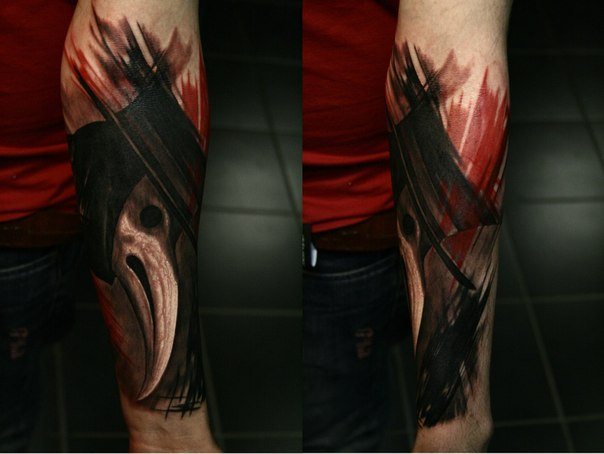

The meaning of .
As you know, no tattoo is not a simple image, because each of them has a certain meaning. The meaning of the plague doctor tattoo is largely determined by the aforementioned historical events. Before prescribing the meaning itself, it is worth pointing out that the image can only be found on the body of very brave people who are not afraid to show others their special attitude towards life. That is why such tattoos can be equally seen in men and women.
So, there are two main options for the meaning of the plague doctor tattoo:
- Fatalism. By putting this image on his body, a person emphasizes that he is completely at the mercy of fate. Wherever life may direct the wearer of such a tattoo, he will calmly drift with the certainty that everything has long been predetermined.
- The challenge of death. Since plague doctors themselves were daily on the brink between life and death, it is believed that the presence of such a tattoo means that a person is not only not afraid of death, but is ready to challenge it.
In addition to the above, it should be understood that each person can interpret the meaning of the plague doctor tattoo for themselves differently. After all, even one added detail can make a big difference.
The choice of style
Realism is considered one of the most difficult styles to perform. In order for the work to be truly realistic, the master must also be a talented artist. In this style most often perform portraits, images of animals, and landscapes in experienced masters are breathtaking. A realistic plague doctor can look very cool.
Another appropriate style is the trashy polka dot. It just screams: "down with the banality and templates!". Find beauty in the ugly, to exalt the repulsive - that's the essence of thrash polka. The plague doctor is associated with sickness, a noxious stench, putrefaction, and the inevitability of death. Isn't this the right image for this style? Wide careless strokes of red and black will leave no room for ordinariness and monotony.
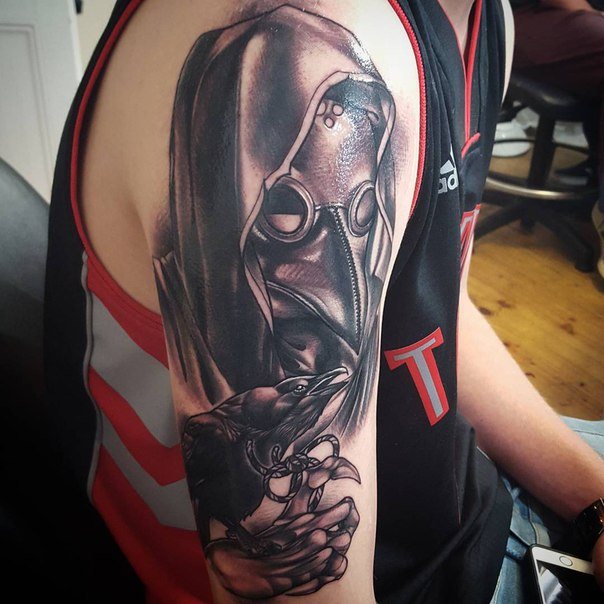

Tips for sketches
As a plague doctor image, the sketch expresses the owner's emotional values. Think about your desire for such a contrasting tattoo. Figure out what it is about it that appeals to you. This will help to gather the most facts that the tattoo artist will use in the drawing.
Recommended reading: Tattoo Masks
Don't take off-the-shelf work, as copying the plague doctor image is considered bad form. A photo from the web can only be used as an illustration of the style in which you want the tattoo.
Choice of location
More often than not, plague doctor images are oblong in shape, so they will look great on the shoulder, forearm, thigh or calves. Making a tattoo on these places, in addition, the most painful. There are also large-scale works on the entire back or ribs. In this case, the closer the master needle will get to the bone, the stronger will be the painful sensations.
As for the time you will have to spend on the work, it all depends on the complexity. A plague doctor does require a certain amount of detail and scale, so most likely one session will not be enough.
An important last tip: never save money on tattoos! Choose a master who in your opinion is the best, study his portfolio carefully. It's better to spend a lot of money once than to spend the rest of your life looking at something on your body that is far from your aesthetic preferences. The plague doctor image mostly involves a tight fill, so if you ever want to get rid of it and do a cover, blackwork is the only way to go.
4.7 / 5 ( 12 votes )
Most popular materials
Tattoos of Elena Letuchaya.
In European culture a plague doctor is known since the Middle Ages, at that time it was a doctor, whose duties included fixing death of people, who died of bubonic plague, or, as it was then called, black death.
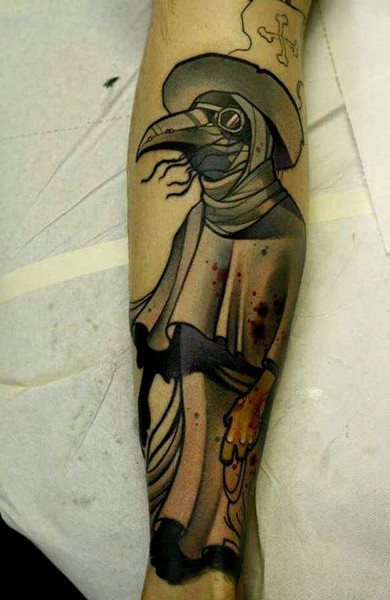

It was practically useless to cure the sick, so people knew that if a plague doctor came into the house, there would be trouble. Plague doctors wore distinctive long-necked masks to protect themselves from infection and the smell of decay. Despite the fact that the plague raged in Europe hundreds of years ago, the meaning of the image of the plague doctor remained unchanged - it is a harbinger of death, an ominous soothsayer.
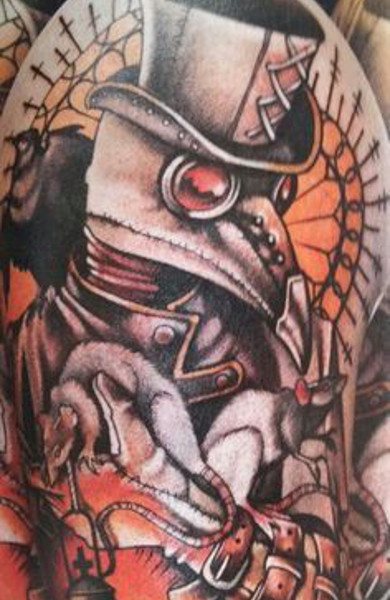

The meaning of the plague doctor tattoo is fatalism, mysticism and confidence that all that is written in the birth will come true. Such tattoos are characteristic of European tattoo culture and practically do not occur in the eastern subculture of body art. In America, people who have done such tattoos are called cheerful suicide bombers, as they show that they are ready to meet death.
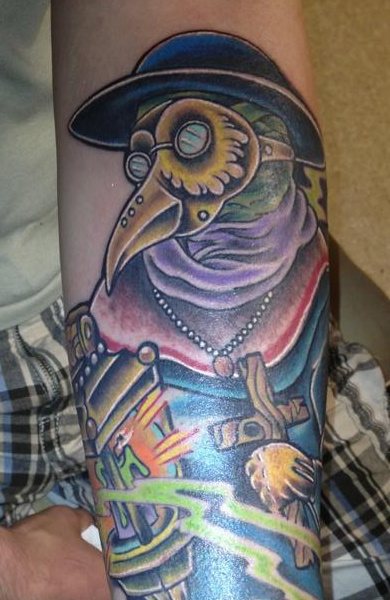

Knowing the cultural and historical context of the plague doctor, tattoos with his image are chosen by brave people who are not strangers to originality and the desire to outrage.
The plague doctor tattoo can be performed both in black and white and in color, and it is applied to any part of the body as desired by the client.
Diploma in Tattoos
I am writing a diploma on the meaning of tattooing for today's urban youth.
Everything is anonymous, no personal details need to be written.
Any questions about it can be posed to me, including the "why is there such a question here" kind of thing. Also looking for master tattoo artists to interview. 

I would be so grateful for your help!
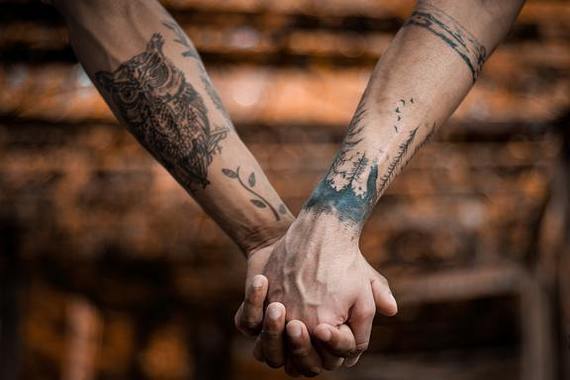

Our stellar recommendations and skin care basics
Regular skin care for your body and hands will keep your skin firm, smooth, and avoid unsightly stretch marks, wrinkles, or age spots. It is necessary to apply a nourishing cream, use special products, do massage and simple exercises.
Skin care of the hands, neck, chest, abdomen and thighs should be systematic, only daily care will give long-awaited results and allow you to enjoy its radiance, smoothness and silkiness.
Light exfoliation with homemade masks will protect it from dryness, flaking, give a radiant look. Tender, firm and tight skin of the whole body emphasizes the youth, health and beauty of any woman. It is very important to take care of it correctly, using a variety of means, doing special exercises.
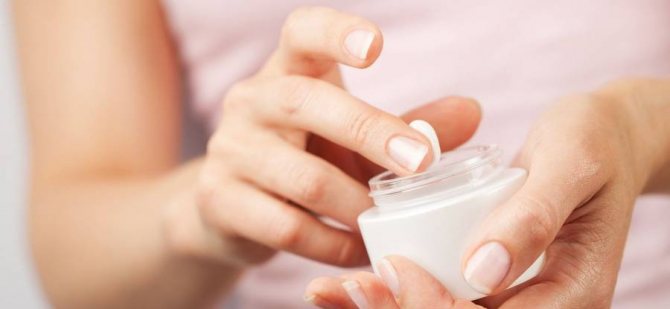

General recommendations for caring for the skin of the body and hands
There are several important rules that any woman should perform strictly. These relate to hygiene of the skin, keeping it clean, using a variety of products and exercise. Here are some important recommendations and rules of care for the body to maintain the elasticity of the skin, keeping it smooth:
- Clean your skin every day by showering with gels, scrubs and foams suitable for your skin type;
- You must massage yourself by stroking, kneading or tweezing certain areas of the body;
- apply the cream in the morning and evening, paying attention to its expiration date, composition;
- to maintain elasticity it is necessary to perform special exercises that help to get rid of cellulite, sagging skin;
- the daily menu should include protein foods, vegetables and fruit dishes, meat or fish, cereals;
- Bathing, swimming, sports and walks have a good effect.
Skin care should begin with morning exercises, contrast showers, not forgetting the use of nourishing cream, milk.
Dry skin should not be washed with soap, for oily skin should buy an exfoliating scrub with clay. It is better to apply and wash off the gel with a massage mitten, and then you need to rub the whole body with a thick terry towel.
How to Care for Rough and Dry Hands
The most unpleasant thing for well-groomed women at any time of year is dry skin on the back of the hands, reddened from frost, coarsened from garden work with calluses and cracks. The right care for dry hands helps to avoid these annoying manifestations, soften it, moisturize and give a gentle touch. Here are some basic tips for getting rid of dry skin on your hands:
- while washing your palms with soap or gel, you should do a light massage, stroking the skin with gentle movements;
- do not apply cream until the skin is completely dry, so that it can be absorbed better;
- in frosty weather, wear gloves and apply protective cream to the palms of your hands;
- Do not keep your hands in water for a long time;
- the cream should be an oily, nourishing or moisturizing, day and night.
Rules for skin care of the neck, chest
Skin care for delicate areas such as the neck and chest requires following certain rules. Here are the most basic ones:
- you should massage with warm palms, but stretching, pinching and strong wrinkling of the skin is prohibited;
- When washing in the shower, you must use only gel, exfoliating scrubs and peels do not apply to the breasts;
- Be sure to gently dry your neck and chest with a terry towel, then you must apply a fatty moisturizing or nourishing cream, milk;
- massage movements should be stroking, shower - contrast;
- Once a week, you can make a moisturizing mask, using store-bought products or natural recipes from herbs, products, oils;
- Be sure to wear a comfortable bra, avoid constricting, tight clothing, rigid collars.
Advice on caring for the skin of the abdomen
The skin on the abdomen is not as soft as on the face or breasts. It is more elastic and can stretch a lot during pregnancy. Because of this, many women get stretch marks, sagging, and scars. Skin care for the abdomen should be guided by the following rules:
- A strong loss or gain of weight leads to stretching of the skin, its sagging, it is necessary to monitor the weight of the body, lose weight gradually;
- Pregnant ladies should use special creams, wear a bandage, belt;
- in the shower to massage the abdomen, using scrubs, ointments on herbs, masks with clay, sea salt, honey;
- massage movements should be painless, pinching, rubbing, stroking should be clockwise, gathering the skin in folds;
- Anti-cellulite or draining gels help warm up the skin, removing excess fluid from the cells;
- Need to take a contrast shower, apply cream against stretch marks, rub your belly with a stiff towel or a massage mitten, brush.
Rules for skin care of the thighs and buttocks
The rules of skin care on the thighs, buttocks and lower back do not differ from the general recommendations. It is necessary to use special hygiene and care products, to do massage. Here are some useful tips for those who want to have smooth thighs and firm, taut buttocks:
- It is necessary to use anti-cellulite creams with a warming or cooling effect;
- take a contrast shower, alternating the temperature of the water and its pressure;
- the massage should be done with strong movements, using pinching, rubbing, flapping;
- Do not become fat or thin, do not sit still for a long time;
- Do not do without the exercises for the hips and buttocks - they must be performed daily;
- Drink plenty of clean water, do sports, ride a bike, swim and dance.
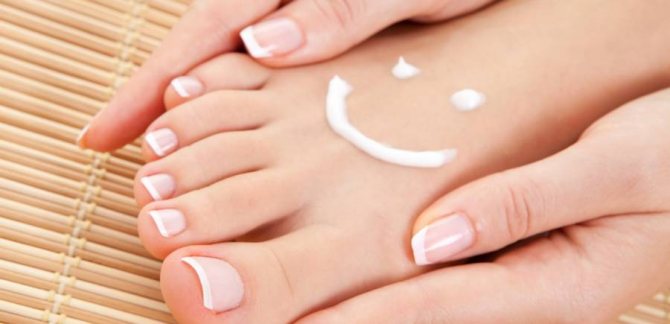

Foot and heel care
Smooth heels and feet look aesthetic, allow you to wear open shoes, do not hesitate to walk barefoot. Care of the heels is to exfoliate, soften, and keep them clean. It is necessary to apply moisturizing or emollient cream on the feet every night, do massage baths with herbs and sea salt. To heels will always remain smooth, not cracked and not painful, you need:
- Clean them with a pumice stone very carefully, often do it is not desirable;
- Do not forget to wash your feet every day with warm water;
- Apply daily oily nourishing cream, use a spray against sweating;
- Wear only clean dry shoes, socks, and avoid dirt;
- If corns or calluses have appeared, do not cut them off, as the wound can get infected.
All of these fairly simple body skin care procedures should be performed systematically. Even if your hands or thighs look smooth and your belly looks taut, you shouldn't skimp on massages, contrast showers and scrubs. The effect of care must be maintained constantly, so that it remains supple, silky, very soft to the touch.
My favorite work.
Saw a great post Scandinavian-themed tattoos and decided to share my Scandinavian-themed work with you.
I know the owner of the tattoo also sits on Picaboo. Sergei, hi. 

